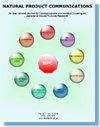Protective Effect of Chikusetsu saponin IVa on Hydrogen Peroxide Induced Injury of IPEC-J2 Cells
IF 1.4
4区 医学
Q4 CHEMISTRY, MEDICINAL
引用次数: 0
Abstract
Objectives: Chikusetsu saponin IVa (CHS-IVa) is a saponin compound widely found in herbs such as Panax japonicus C.A.Mey, which has various functions. The purpose of this study was to investigate the protective effect of CHS-IVa on oxidative stress and inflammation in porcine intestinal epithelial cells (IPEC-J2) under the action of hydrogen peroxide (H筑雪皂苷 IVa 对过氧化氢诱导的 IPEC-J2 细胞损伤的保护作用
研究目的筑雪皂苷Ⅳa(CHS-Ⅳa)是一种广泛存在于三七等中草药中的皂苷化合物,具有多种功能。本研究旨在探讨 CHS-IVa 在过氧化氢(H2O2)作用下对猪肠上皮细胞(IPEC-J2)氧化应激和炎症的保护作用。研究方法用 MTT 法检测细胞活力。细胞划痕实验用于检测 CHS-IVa 对细胞的修复能力。使用相关试剂盒检测乳酸脱氢酶(LDH)、过氧化氢酶(CAT)、超氧化物歧化酶(SOD)、谷胱甘肽(GSH)、硫氧还原酶(TrxR)和丙二醛(MDA)的水平。通过 qPCR 检测 TNF-α、NF-κB、IL-6、IL-1α 和 P65 的表达水平。结果显示MTT 结果显示,50 至 100 μg/mL 的 CHS-IVa 可在 24 小时内增强 IPEC-J2 细胞的活性。80 和 100 μg/mL 的 CHS-IVa 能促进损伤修复,并有效抑制 IPEC-J2 细胞在暴露于 H2O2 后释放 LDH。此外,它还对 TrxR、SOD、GSH 和 CAT 的损失有修复作用。同时,CHS-IVA 还能显著降低 H2O2 处理后 NF-κB、IL-6 和 P65 的 mRNA 表达。结论这些研究结果表明,特定浓度的 CHS-IVa 在氧化应激过程中对 IPEC 有保护作用,从而增强其修复损伤的能力。
本文章由计算机程序翻译,如有差异,请以英文原文为准。
求助全文
约1分钟内获得全文
求助全文
来源期刊

Natural Product Communications
工程技术-食品科技
CiteScore
3.10
自引率
11.10%
发文量
254
审稿时长
2.7 months
期刊介绍:
Natural Product Communications is a peer reviewed, open access journal studying all aspects of natural products, including isolation, characterization, spectroscopic properties, biological activities, synthesis, structure-activity, biotransformation, biosynthesis, tissue culture and fermentation. It covers the full breadth of chemistry, biochemistry, biotechnology, pharmacology, and chemical ecology of natural products.
Natural Product Communications is a peer reviewed, open access journal studying all aspects of natural products, including isolation, characterization, spectroscopic properties, biological activities, synthesis, structure-activity, biotransformation, biosynthesis, tissue culture and fermentation. It covers the full breadth of chemistry, biochemistry, biotechnology, pharmacology, and chemical ecology of natural products.
Natural Product Communications is a peer reviewed, open access journal studying all aspects of natural products, including isolation, characterization, spectroscopic properties, biological activities, synthesis, structure-activity, biotransformation, biosynthesis, tissue culture and fermentation. It covers the full breadth of chemistry, biochemistry, biotechnology, pharmacology, and chemical ecology of natural products.
 求助内容:
求助内容: 应助结果提醒方式:
应助结果提醒方式:


